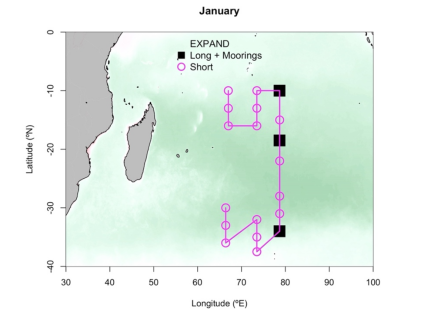[IIOE2-EP53] will nitrogEn fiXaTion offset nitrogen dePletion in expAnding oceaN Deserts? (EXPAND)
Lead Investigator :
- Mar Benavides, Mediterranean Institute of Oceanography,Batiment OCEANOMED, Campus de Luminy 1328, Marseille, France
mar.benavides[at]ird[dot]fr
Period of Project: January 2025 - December 2030
Brief description of the Project:
The warming and nutrient depleted conditions induced by climate change are bound to force changes in resource supply to fuel primary productivity. Biological nitrogen fixation provides the largest source of reactive nitrogen in oligotrophic regions and responds positively to experimental temperature and CO2 increases expected towards the end of the 21st century.
A comparison of the two last generations of Earth system models indicates that the parametrisation of nitrogen fixation has a profound impact in net primary productivity predictions towards the end of the 21st century. Among the global ocean regions, this increased global uncertainty is significantly driven by the Indian Ocean. However, the Indian Ocean represents only ~1% of the nitrogen fixation data available to date. Hence, constraining nitrogen fixation in the Indian Ocean gyre is crucial to improve the predictability of net primary productivity and the future role of the ocean as a climate change regulator.
EXPAND will provide mechanistic and quantitative understanding on how nitrogen fixation changes with gyre expansion seasonally, and its impact on primary productivity and export. This information will provide precious data coverage in this severely undersampled region, feeding models for a better parametrisation of nitrogen fixation and improved predictability of biological productivity in the future ocean.
Region of study:
EXPAND aims to quantitatively understand the impact of the Indian Ocean subtropical gyre (hereafter only âgyreâ) expansion on biological nitrogen fixation and its subsequent impact on primary productivity.
The objectives are:
- TRACK: Locating and measuring seasonal change in Indian Ocean gyre expansion
- IMPACT: Understanding and quantifying the impact of gyre expansion on diazotrophic nitrogen inputs
- LEGACY: Extending in situ measurements for nitrogen availability predictability in the future Ocean
The cruise strategy consists of a series of stations crossing the upper and lower boundaries of the gyre (see figure below), with underway sampling between them. During the first cruise (July 2025), three fixed moorings will be installed at three key locations chosen to cover the maximum latitudinal seasonal variability of the gyre boundaries, recovered on a shorter cruise after one year (July 2026).


